Key Scottish Environment Statistics 2015
This publication aims to provide an easily accessible reference document which offers information on a wide range of environmental topics. It covers key datasets on the state of the environment in Scotland, with an emphasis on the trends over time wherever possible. The data are supplemented by text providing brief background information on environmental impacts and data source, a summary of the trend and brief information on the potential factors affecting the trend.
Land
Background
Land is an important part of the Scottish environment, supporting a range of habitats and species and providing a wealth of benefits such as food, timber, clean water, energy and employment. The way in which land is used and managed has implications for many areas such as water pollution, greenhouse gas emissions, human health and the economy; and is vital to the sustainability of the environment as a whole[95].
Land Use Strategy
From Scotland's Environment website - Get Informed section[96],[97]
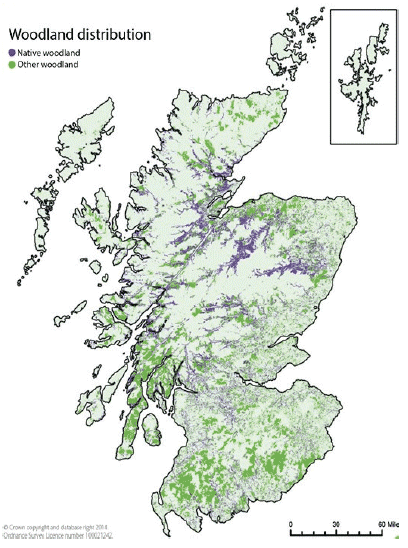
One of the outcomes of the Scottish Government Greener Objective[98] is to protect and enhance the natural environment. The Land Use Strategy[99], which is one of the commitments of the Climate Change (Scotland) Act 2009, aims to support this by providing a set of Principles for Sustainable Land Use to guide policy and decision making in relation to land use.
Forestry
There are also specific guidelines in place to encourage the sustainable management of different sectors. For instance, the UK Forestry Standard sets out the standards for the sustainable management of all forests in the UK, on which the independent certification schemes for sustainable forest management are based.
The provisional figure for 2015 shows that 57% of Scotland's woodland area is certified as sustainably managed (813,000 hectares)[100], although woodland that is not certified may also be managed sustainably.
Targets and Indicators
There are two National Indicators that relate to Scotland's land:
- Improve people's use of Scotland's outdoors[101]
- Improve the condition of protected nature sites[102]
The Land Use Strategy also has ten indicators that measure progress towards the delivery of the three Objectives of the Strategy[103].
Derelict and Urban Vacant Land: 2008-2014R
Area of derelict and urban vacant land (hectares)[104]
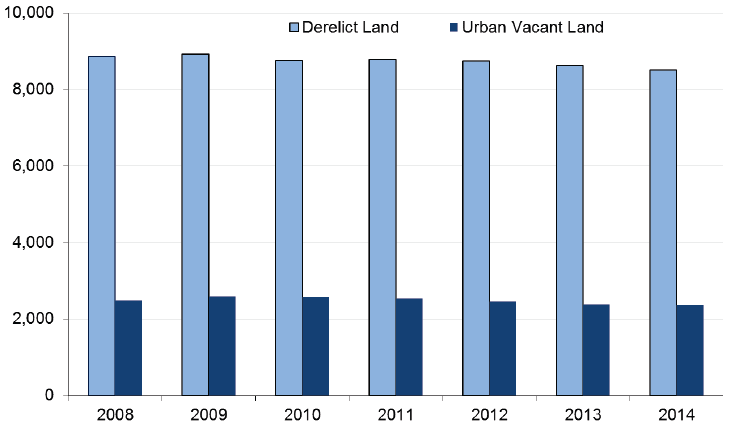
Why this measure is important
Derelict land together with vacant land in urban areas is an unused resource. Vacant land is land which is unused for the purposes for which it is held and is viewed as an appropriate site for development. Derelict land (and buildings) is land which has been so damaged by development that it is incapable of being developed for beneficial use without rehabilitation[105].
Background
The Scottish Vacant and Derelict Land Survey is an annual data collection managed by the Scottish Government using data sourced from local authorities and the Loch Lomond and Trossachs National Park Authority. The main purpose of the survey is to provide a national data source to inform the programming of the rehabilitation, planning and reuse of derelict and urban vacant sites.
Trend
The latest figures show that the total area of derelict and urban vacant land has decreased by 4%, from 11,333 hectares in 2008 to 10,874 hectares in 2014[106]. This change is the result of a fall of 350 hectares (4%) in the area of derelict land and a fall of 111 hectares (4%) in the area of urban vacant land over the same period.
Factors affecting trend
The area of urban vacant and derelict land that is brought back into use each year can depend on the land's development potential, it's previous use and the potential funding available. In 2014, the most common new uses of the derelict and urban vacant land brought back into use were residential development (39%) and agriculture (12%). There may also be changes in the recorded area of existing sites from year to year.
Source: Scottish Government | Metadata
Agricultural Land Use: 1982-2014[107]
Area (thousand hectares)
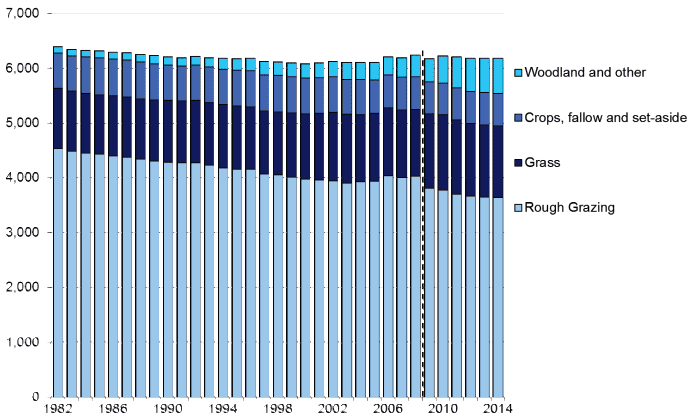
Why this measure is important
Agricultural land use has a strong influence on the landscape and environment of Scotland. In particular, changes in agricultural land use have an impact on wildlife habitats, water pollution, and greenhouse gas emissions. Approximately four fifths of Scotland's land is used for agriculture, although this may also be used for other purposes[108].
Background
There is a step change in the agricultural land use data series in 2009, following a switch in data source to the Single Application Form, which is combined with the land use data from all other holdings collected through the June Agricultural Census Forms to generate the overall June Agricultural Census results.[109] This means that post 2009 data is not directly comparable to previous years and so trends should be treated with caution.
Trend
Between 1982 and 2014, the total land used for agriculture in Scotland decreased by around 3%. After the introduction of the Single Application Form data in 2009, the area of land used for agriculture was recorded as 6,176,800 hectares. This increased to 6,180,200 hectares in 2014. Since 2009, the area of woodland and other land[110] has increased by 222,500 hectares (53%) to 642,000 hectares in 2014; whereas the area of land used for rough grazing and the area of grass have decreased by 169,000 hectares (4%) and 53,000 hectares (4%) respectively over the same period.
Factors affecting trend
The increase in woodland and other land may be due, in part, to increased coverage by the June Census register but this rise is consistent with increases in woodland over the same time period, indicating that this trend may reflect genuine change. The reduction in the area of grass over the past year has been driven by the fall in the area of temporary grass. Other factors such as the weather, which can affect the sowing of crops, can also have an effect on agricultural land use trends.
Source: Scottish Government | Metadata
Nutrients Applied to Crops and Grass: 1986-2014
Total nutrients applied to crops and grass (kg/ha)[111]
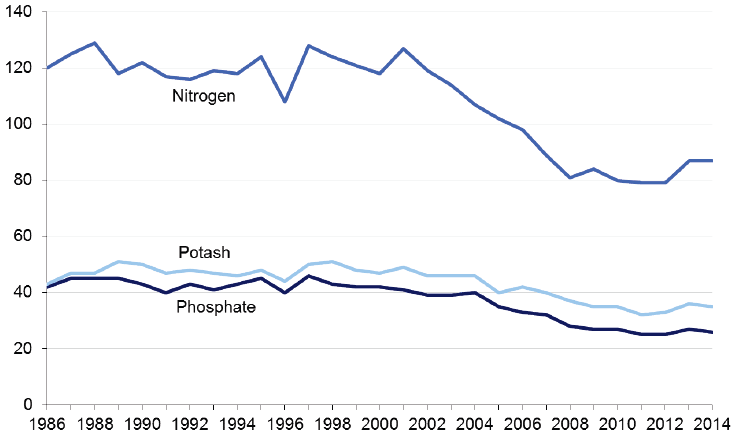
Why this measure is important
Fertilisers contain nutrients, such as nitrogen, phosphorus and potassium, which improve plant growth and crop yields. However, the inappropriate or mistimed use of fertilisers may cause nutrient enrichment and eutrophication of waters.
Background
Data on fertiliser[112] use is obtained from the British Survey of Fertiliser Practice, which is an annual survey based on a representative sample of farms which vary from year to year. The main purpose of the survey is to estimate average rates of nitrogen, phosphate and potash applied to agricultural crops and grassland[113].
Trend
Between 1986 and 2004, overall phosphate and potash application rates remained relatively stable. Both have since declined in recent years; however there has been a slight increase in application rates since 2012. Nitrogen application rates have declined overall since 2001, although they increased by 10% between 2012 and 2013. There was no change in nitrogen application rates between 2013 and 2014. However, even with these increases, the application rates for all three nutrients remain below the rates applied before 2008.
Factors affecting trend
Changes in overall application rates are linked to changes in the proportion of crop area treated, changes in the proportion of autumn and spring sown crops, changes in the amounts of crops/grass grown and changes in the average rate of application for particular crops. There are also mandatory rules on farming practices in Nitrate Vulnerable Zones (NVZs)[114], which aim to reduce nitrate water pollution from agricultural sources, that may affect trends in fertiliser use. Weather and economic factors may also contribute to changes in fertiliser use.
Source: Defra / Scottish Government | Metadata
Area of Woodland: 1924-2015P[115]
Area (thousand hectares)
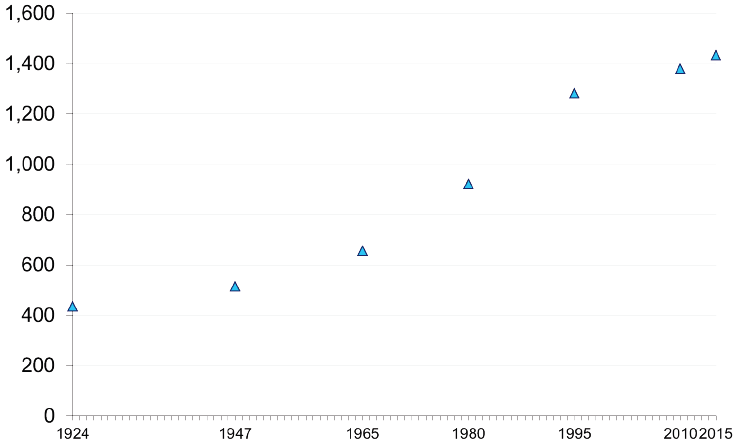
Why this measure is important
Woodland is important as it provides wildlife habitats and can contribute to the sustainable production of wood products and paper. Woodland also contributes to the removal of carbon dioxide from the atmosphere, with the Forestry sector acting as a carbon sink.
Background
Data are obtained from forest inventories; however, most inventories have slightly different definitions of woodland and so some apparent changes in area over time are due to changing definitions. Data for 2015, as at 31st March, are early provisional results obtained from 'Woodland Area, Planting and Restocking: 2015 Edition'[116].
Trend
Provisional figures show that, in 2015, the area of woodland in Scotland was 1,432,000 hectares (18.2% of the total Scottish land area). This compares with 16.4% of the total land area in 1995 and 11.8% in 1980. 74% of the area of woodland is made up of conifers and 26% made up of broadleaved species, both native and introduced. Provisional figures show that 7,600 hectares of new woodland was planted in 2014-15.
Factors affecting trend
Increases in woodland area are mainly the result of new planting, which has increased in recent years due to the introduction of Scottish Rural Development Contracts, or by natural colonisation of trees on land near existing woodland. Decreases in woodland area can result from the conversion of woodland to other land uses. Regulatory approval, which normally requires the area to be restocked117, is usually required before trees can be felled. However, there are some cases in which trees may be permanently removed, generally for environmental reasons. The permanent removal of trees may also be authorised under planning regulations, to enable development.
Source: Forestry Commission | Metadata
Contact
Email: Kirsty Ciclitira
There is a problem
Thanks for your feedback